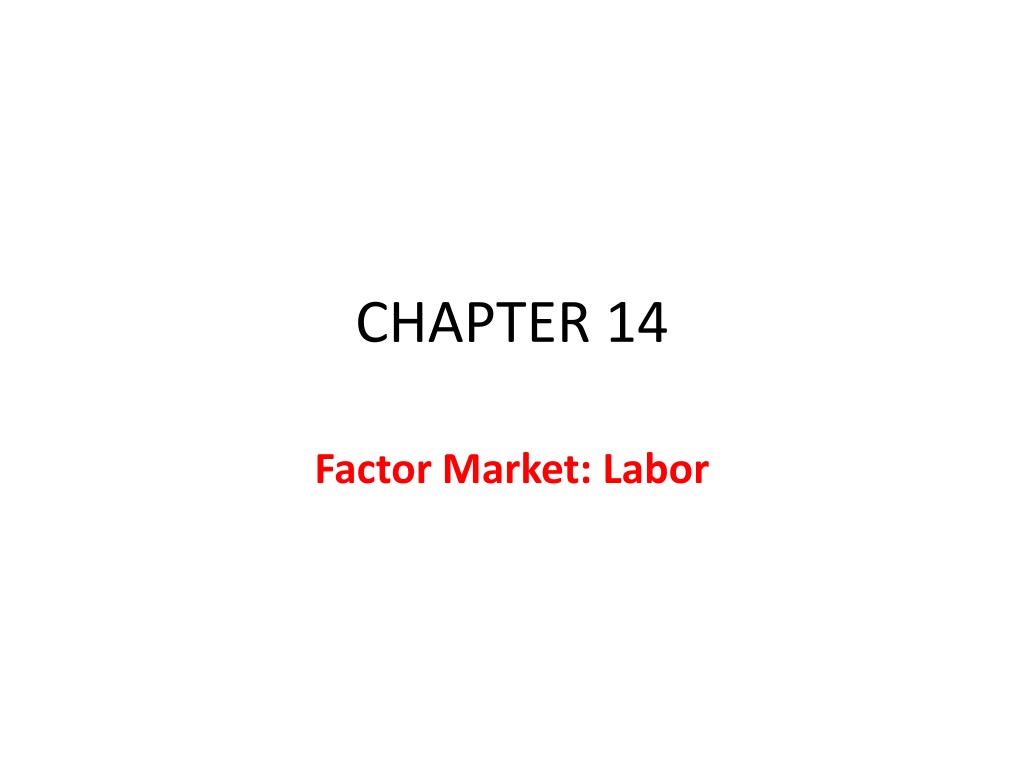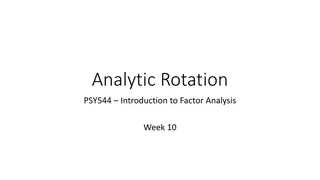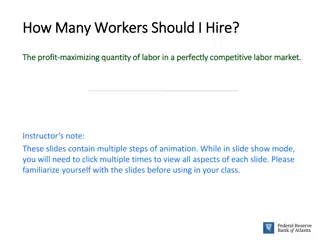Understanding Competitive Factor Market in Labor Economics
A competitive factor market involves a large number of sellers and buyers of a factor of production, like labor. With no single entity influencing prices, each acts as a price taker. The demand for factors depends on firms' output levels and input costs, leading to derived demands. Profitability of hiring additional labor is determined by comparing marginal revenue product of labor (MRPL) to wage rate. In a competitive output market, firms sell at market price P, making MRPL equal to the marginal product of labor times the product price.
Download Presentation

Please find below an Image/Link to download the presentation.
The content on the website is provided AS IS for your information and personal use only. It may not be sold, licensed, or shared on other websites without obtaining consent from the author. Download presentation by click this link. If you encounter any issues during the download, it is possible that the publisher has removed the file from their server.
E N D
Presentation Transcript
CHAPTER 14 Factor Market: Labor
COMPETITIVE FACTOR MARKET A competitive factor market is one in which there are a large number of sellers and buyers of a factor of production, such as labor or raw materials. Because no single seller or buyer can affect the price of a given factor, each is a price taker. We begin by analyzing the demands for a factor by individual firms. These demands are added to get market demand. We then shift to the supply side of the market and show how market price and input levels are determined.
Demand for a Factor Input When Only One Input Is Variable Like demand curves for the final goods that result from the production process, demand curves for factors of production are downward sloping. Unlike consumers demands for goods and services, however, factor demands are derived demands: They depend on, and are derived from, the firm s level of output and the costs of inputs. For example, the demand of the Microsoft Corporation for computer programmers is a derived demand that depends not only on the current salaries of programmers, but also on how much software Microsoft expects to sell.
Suppose that the firm has hired a certain number of workers and wants to know whether it is profitable to hire one additional worker. This will be profitable if the additional revenue from the output of the worker s labor is greater than its cost. The additional revenue from an incremental unit of labor, the marginal revenue product of labor, is denoted MRPL. The cost of an incremental unit of labor is the wage rate, w. Thus, it is profitable to hire more labor if the MRPLis at least as large as the wage rate w.
derived demand Demand for an input that depends on, and is derived from, both the firm s level of output and the cost of inputs. marginal revenue product Additional revenue resulting from the sale of output created by the use of one additional unit of an input. How do we measure the MRPL? It s the additional output obtained from the additional unit of this labor, multiplied by the additional revenue from an extra unit of output. (14.1) This important result holds for any competitive factor market, whether or not the output market is competitive.
However, to examine the characteristics of the MRPL, lets begin with the case of a perfectly competitive output (and input) market. In a competitive output market, a firm will sell all its output at the market price P. The marginal revenue from the sale of an additional unit of output is then equal to P. In this case, the marginal revenue product of labor is equal to the marginal product of labor times the price of the product: (14.2)
The marginal revenue product of labor (MRPL) is the additional amount of revenue a firm can generate by hiring one additional employee. It is found by multiplying the marginal product of labor (MPL) the amount of additional output one additional worker can generate by the price of output. If an employee of a customer support call center can take eight calls an hour (the MPL) and each call earns the company $3, then the MRPLis $24. We can use the MRPLcurve to determine the quantity of labor a company will hire. Suppose workers are available at an hourly rate of $10. The amount a factor adds to a firm s total cost per period is the marginal cost of that factor, so in this case the marginal cost of labor is $10. Firms maximize profit when marginal costs equal marginal revenues, and in the labor market this means that firms will hire more employees until the wage rate (marginal cost of labor) equals the MRPL. At a price of $10, the company will hire workers until the last worker hired gives a marginal revenue product of $10.
The marginal revenue product of labor (MRPL) is the change in revenue that results from employing an additional unit of labor, holding all other inputs constant. The marginal revenue product of a worker is equal to the product of the marginal product of labor (MPL) and the marginal revenue (MR) of output, given by MR MPL= MRPL. This can be used to determine the optimal number of workers to employ at an exogenously determined market wage rate. Theory states that a profit maximizing firm will hire workers up to the point where the marginal revenue product is equal to the wage rate, because it is not efficient for a firm to pay its workers more than it will earn in revenues from their labor. For example, if a firm can sell t-shirts for $10 each and the wage rate is $20/hour, the firm will continue to hire workers until the marginal product of an additional hour of work is two t-shirts. If the MPL is three t-shirts the first will hire more workers until the MPL reaches two; if the MPL is one t-shirt then the firm will remove workers until the MPL reaches two.
Let TR=Total Revenue; L=Labor; Q=Quantity. Mathematically: MRPL= TR/ L MR = TR/ Q MPL = Q/ L MR x MPL = ( TR/ Q) x ( Q/ L) = TR/ L Because the MRPL is equal to the marginal product of labor times the price of output, any variable that affects either MPL or price will affect the MRPL. For example, changes in technology or the quantity of other inputs will change the marginal product of labor, and changes in the product demand or changes in the price of complements or substitutes will affect the price of output. These will all cause shifts in the MRPL.
Shifting the Demand for Labor There are three main reasons why the demand curve for labor may shift: 1. Changes to the marginal productivity of labor: Technology, for instance, may increase the marginal productivity of labor, shifting the demand curve to the right. For example, computer technology has increased the productivity (marginal product) of many types of workers. This has led to an increase in the marginal revenue product of labor for these jobs, shifting firms demand for labor to the right. This both increases the number of employed workers and increases the wage rate. 2. The prices of other factors of production: The change in the relative price of labor will increase or decrease demand for labor. For example, is capital becomes more expensive relative to labor, the demand for labor will increase as firms seek to substitute labor for capital. 3. The price of the firm s output: Since the price of the output is a component of MRPL, changes will shift the demand curve for labor. If the price that a firm can charge for its output increases, for example, the MRPL will increase. This is reflected in an outward shift of the demand for labor.
Deriving the Labor Demand Curve Firms will demand labor until the marginal revenue product of labor is equal to the wage rate. Firms demand labor and an input to production. The cost of labor to a firm is called the wage rate. This can be thought of as the firm s marginal cost. The additional revenue generated by hiring one more unit of labor is the marginal revenue product of labor (MRPL). This can be thought of as the marginal benefit.
The MPL falls as the amount of labor employed increases. The optimum demand for labor falls where the real wage rate (w/P) is equal to the MPL. Thus, the downward-sloping portion of the marginal revenue product curve shows the number of employees a company will hire at each price (wage), so we can interpret this part of the curve as the firm s demand for labor. As with other demand curves, the market demand curve for labor is the sum of all firm s individual demand curves.
Figure 14.1 Marginal Revenue Product In a competitive factor market in which the producer is a price taker, the buyer s demand for an input is given by the marginal revenue product curve. The MRP curve falls because the marginal product of labor falls as hours of work increase. When the producer of the product has monopoly power, the demand for the input is also given by the MRP curve. In this case, however, the MRP curve falls because both the marginal product of labor and marginal revenue fall.
Note that the marginal revenue product tells us how much the firm should be willing to pay to hire an additional unit of labor. As long as the MRPL is greater than the wage rate, the firm should hire more labor. If the marginal revenue product is less than the wage rate, the firm should lay off workers. Only when the marginal revenue product is equal to the wage rate will the firm have hired the profit- maximizing amount of labor. The profit-maximizing condition is therefore: (14.3)
Figure 14.2 Hiring by a Firm in the Labor Market (with Fixed Capital) In a competitive labor market, a firm faces a perfectly elastic supply of labor SLand can hire as many workers as it wants at a wage rate w*. The firm s demand for labor DLis given by its marginal revenue product of labor MRPL. The profit-maximizing firm will hire L* units of labor at the point where the marginal revenue product of labor is equal to the wage rate. Because competitive, the firm can hire as many workers as it wants at the market wage w* and is not able to affect the market wage. The supply of labor curve facing the firm SL is thus a horizontal line. The profit-maximizing amount of labor that the firm hires, L*, is at the intersection of the supply and demand curves. the labor market is perfectly
Figure 14.3 Figure 14.3 shows how the quantity of labor demanded changes in response to a drop in the market wage rate from w1 to w2. The wage rate might decrease if more people entering the labor force are looking for jobs for the first time (as happened, for example, when the baby boomers came of age). The quantity of labor demanded by the firm is initially L1, at the intersection of MRPL and S1.
However, when the supply of labor curve shifts from S1to S2, the wage falls from w1to w2and the quantity of labor demanded increases from L1to L2. Factor markets are similar to output markets in many ways. For example, the factor market profit- maximizing condition that the marginal revenue product of labor be equal to the wage rate is similar to the output market condition that marginal revenue be equal to marginal cost. To see why this is true, recall that MRPL= (MPL)(MR) and divide both sides of equation (14.3) by the marginal product of labor. Then, (14.4) Because MPL measures additional output per unit of input, the right-hand side of equation (14.4) measures the marginal cost of an additional unit of output. Equation (14.4) shows that both the hiring and output choices of the firm follow the same rule: Inputs or outputs are chosen so that marginal revenue (from the sale of output) is equal to marginal cost (from the purchase of inputs). This principle holds in both competitive and noncompetitive markets.
Demand for a Factor Input When Several Inputs Are Variable When the firm simultaneously chooses quantities of two or more variable inputs, the hiring problem becomes more difficult because a change in the price of one input will change the demand for others. Suppose, for example, that both labor and inputs for producing farm equipment. machinery are variable Let s say that we wish to determine the firm s demand for labor curve. As the wage rate falls, more labor will be demanded even if the firm s investment in machinery is unchanged. But as labor becomes less expensive, the marginal cost of producing the farm equipment falls. Consequently, it is profitable for the firm to increase its output. In that case, the firm is likely to invest in additional machinery to expand production capacity. Expanding the use of machinery causes the marginal revenue product of labor curve to shift to the right; in turn, the quantity of labor demanded increases. Figure 14.4 illustrates this.
Figure 14.4 Firm s Demand Curve for Labor (with Variable Capital) When two or more inputs are variable, a firm s demand for one input depends on the marginal revenue product of both inputs. When the wage rate is $20, A represents one point on the firm s demand for labor curve. When the wage rate falls to $15, the marginal product of capital rises, encouraging the firm to rent more machinery and hire more labor. As a result, the MRP curve shifts from MRPL1to MRPL2, generating a new point C on the firm s demand for labor curve. Thus A and C are on the demand for labor curve, but B is not.
Note that as constructed, the demand for labor curve is more elastic than either of the two marginal product of labor curves (which presume no change in the amount of machinery). Thus, when capital inputs are variable in the long run, there is a greater elasticity of demand because firms can substitute capital for labor in the production process.
The Market Demand Curve When we aggregated the individual demand curves of consumers to obtain the market demand curve for a product, we were concerned with a single industry. However, a factor input such as skilled labor is demanded by firms in many different industries. Moreover, as we move from industry to industry, we are likely to find that firms demands for labor (which are derived in part from the demands for the firms output) vary substantially. Therefore, to obtain the total market demand for labor curve, we must first determine each industry s demand for labor, and then add the industry demand curves horizontally. The second step is straightforward. Adding industry demand curves for labor to obtain a market demand curve for labor is just like adding individual product demand curves to obtain the market demand curve for that product. So let s concentrate our attention on the more difficult first step.
DETERMINING INDUSTRY DEMAND The first stepdetermining industry demand takes into account the fact that both the level of output produced by the firm and its product price change as the prices of the inputs to production change. It is easiest to determine market demand when there is a single producer. In that case, the marginal revenue product curve is the industry demand curve for the input. When there are many firms, however, the analysis is more complex because of the possible interaction among the firms. Consider, for instance, the demand for labor when output markets are perfectly competitive. Then, the marginal revenue product of labor is the product of the price of the good and the marginal product of labor (see equation 14.2), as shown by the curve MRPL1 in Figure 14.5 (a).
Figure 14.5 The Industry Demand for Labor The demand curve for labor of a competitive firm, MRPL1 in (a), takes the product price as given. But as the wage rate falls from $15 to $10 per hour, the product price also falls. Thus the firm s demand curve shifts downward to MRPL2. As a result, the industry demand curve, shown in (b), is more inelastic than the demand curve that would be obtained if the product price were assumed to be unchanged.
In Figure 14.5 (a), when the product price falls, the original marginal revenue product curve shifts downward, from MRPL1 to MRPL2. This shift results in a lower quantity of labor demanded by the firm 120 worker-hours rather than 150. Consequently, industry demand for labor will be lower than it would be if only one firm were able to hire workers at the lower wage. Figure 14.5 (b) illustrates this. The lighter line shows the horizontal sum of the individual firms demands for labor that would result if product price did not change as the wage falls. The darker line shows the industry demand curve for labor, which takes into account the fact that product price will fall as all firms expand their output in response to the lower wage rate. When the wage rate is $15 per hour, industry demand for labor is L0 worker- hours. When it falls to $10 per hour, industry demand increases to L1. Note that this is a smaller increase than L2, which would occur if the product price were fixed. The aggregation of industry demand curves into the market demand curve for labor is the final step: To complete it, we simply add the labor demanded in all industries.
The Supply of Inputs to a Firm When the market for a factor input is perfectly competitive, a firm can purchase as much of that input as it wants at a fixed market price, which is determined by the intersection of the market demand and supply curves, as shown in Figure 14.7 (a). The input supply curve facing a firm is then perfectly elastic. Thus, in Figure 14.7 (b), a firm is buying fabric at $10 per yard to sew into clothing. Because the firm is only a small part of the fabric market, it can buy all it wants without affecting the price.
Figure 14.7 average expenditure curve Supply curve representing the price per unit that a firm pays for a good. marginal expenditure curve Curve describing the additional cost of purchasing one additional unit of a good. Profit maximization requires that marginal revenue product be equal to marginal expenditure: (14.5)
In the competitive case, the condition for profit maximization is that the price of the input be equal to marginal expenditure: (14.6) In a competitive factor market, a firm can buy any amount of the input it wants without affecting the price. Therefore, the firm faces a perfectly elastic supply curve for that input. As a result, the quantity of the input purchased by the producer of the product is determined by the intersection of the input demand and supply curves. In (a), the industry quantity demanded and quantity supplied of fabric are equated at a price of $10 per yard. In (b), the firm faces a horizontal marginal expenditure curve at a price of $10 per yard of fabric and chooses to buy 50 yards.
How much of the input should a firm facing a competitive factor market purchase? As long as the marginal revenue product curve lies above the marginal expenditure curve, profit can be increased by purchasing more of the input because the benefit of an additional unit (MRP) exceeds the cost (ME). However, when the marginal revenue product curve lies below the marginal expenditure curve, some units yield benefits that are less than cost. Therefore, profit maximization requires that marginal revenue product be equal to marginal expenditure: (14.5) When we considered the special case of a competitive output market, we saw that the firm bought inputs, such as labor, up to the point at which the marginal revenue product was equal to the price of the input w, as in equation (14.3). In the competitive case, therefore, the condition for profit maximization is that the price of the input be equal to marginal expenditure: (14.6)
The Market Supply of Inputs The market supply curve for a factor input is usually upward sloping. We saw that the market supply for a good sold in a competitive market is usually upward sloping because the marginal cost of producing the good is typically increasing. This is also the case for fabric and other raw material inputs. When the input is labor, people rather than firms are making supply decisions. In this case, utility maximization by workers rather than profit maximization by firms determines supply. We see that labor supply curve may be backward bending. To see why a labor supply curve may be backward bending, divide the day into hours of work and hours of leisure. Leisure is a term that describes enjoyable non-work activities, including sleeping, eating, etc. Work benefits the worker only through the income that it generates. We also assume that a worker has the flexibility to choose how many hours per day to work. The wage rate measures the price that the worker places on leisure time, because his or her wage measures the amount of money that the worker gives up to enjoy leisure.
As the wage rate increases, therefore, the price of leisure also increases. This price change brings about both a substitution effect (a change in relative price with utility held constant) and an income effect (a change in utility with relative prices unchanged). There is a substitution effect because the higher price of leisure encourages workers to substitute work for leisure. An income effect occurs because the higher wage rate increases the worker s purchasing power. With higher income, the worker can buy more of many goods, one of which is leisure. If more leisure was chosen, it is because the income effect has encouraged the worker to work fewer hours. Income effects can be large because wages are the primary component of most people s income. When the income effect outweighs the substitution effect, the result is a backward bending supply curve.
Figure 14.8 Backward-Bending Supply of Labor When the wage rate increases, the hours of work supplied increase initially but can eventually decrease as individuals choose to enjoy more leisure and to work less. The backward-bending portion of the labor supply curve arises when the income effect of the higher wage (which encourages more leisure) is greater than the substitution effect (which encourages more work).
There are two effects related to determining supply of labor. The substitution effect states that a higher wage makes work more attractive than leisure. Therefore, in response to higher wages, supply increases because work gives greater remuneration. The income effect states that a higher wage means workers can achieve a target income by working fewer hours. Therefore, if wages increase, it becomes easier to get enough income through working fewer hours.
When does the labor curve begin to slope backwards? It will depend on an individual: If an individual has only modest demands and is interested in leisure pursuits. His/Her goal may be to gain $50,000 a year and then after that maximize leisure time. In this case, after wages increase above $50,000, the income effect dominates, and with higher wages, he can afford to have more time off work. If an individual has large expenses and little interest in leisure pursuits, the substitution effect is likely to have more significance. If wages increase, it gives an increased incentive to work longer hours as he/she can gain increased income and buy more goods.
Other factors affecting labor supply: Job contracts. In the real world, workers cannot easily choose the exact number of hours. Many employees are on fixed contracts. Even if wages rise, they may not have the option of working five fewer hours per week. The motivation for work. Employees are motivated by many factors other than hourly wages. Sometimes workers may stay at a job until they have the satisfaction of completing it. These kinds of motivations can outweigh wages.
SOME OF THE FACTORS THAT WILL CAUSE THE LABOR SUPPLY TO INCREASE OR DECREASE
EQUILIBRIUM IN A COMPETITIVE FACTOR MARKET A competitive factor market is in equilibrium when the price of the input equates the quantity demanded to the quantity supplied. Figure 14.10 (a) shows such an equilibrium for a labor market. At point A, the equilibrium wage rate is wC and the equilibrium quantity supplied is LC. Because they are well informed, all workers receive the identical wage and generate the identical marginal revenue product of labor wherever they are employed. If any worker had a wage lower than her marginal product, a firm would find it profitable to offer that worker a higher wage.
If the output market is also perfectly competitive, the demand curve for an input measures the benefit that consumers of the product place on the additional use of the input in the production process. The wage rate also reflects the cost to the firm and to society of using an additional unit of the input. Thus, at A in Figure 14.10 (a), the marginal benefit of an hour of labor (its marginal revenue product MRPL) is equal to its marginal cost (the wage rate w). When output and input markets are both perfectly competitive, resources are used efficiently because the difference between total benefits and total costs is maximized. Efficiency requires that the additional revenue generated by employing an additional unit of labor (the marginal revenue product of labor, MRPL) equal the benefit to consumers of the additional output, which is given by the price of the product times the marginal product of labor, (P)(MPL).
When the output market is not perfectly competitive, the condition MRPL = (P)(MPL) no longer holds. Note in Figure 14.10 (b) that the curve representing the product price multiplied by the marginal product of labor [(P)(MPL)] lies above the marginal revenue product curve [(MR)(MPL)]. Point B is the equilibrium wage wMand the equilibrium labor supply LM. But because the price of the product is a measure of the value to consumers of each additional unit of output that they buy, (P)(MPL) is the value that consumers place on additional units of labor. Therefore, when LMlaborers are employed, the marginal cost to the firm wMis less than the marginal benefit to consumers vM. Although the firm is maximizing its profit, its output is below the efficient level and it uses less than the efficient level of the input. Economic efficiency would be increased if more laborers were hired and, consequently, more output produced. (The gains to consumers would outweigh the firm s lost profit.)
EQUILIBRIUM IN A COMPETITIVE FACTOR MARKET Figure 14.10 Labor Market Equilibrium In a competitive labor market in which the output market is competitive, the equilibrium wage wc is given by the intersection of the demand for labor (marginal revenue product) curve and the supply of labor curve. This is point A in part (a) of the figure.
EQUILIBRIUM IN A COMPETITIVE FACTOR MARKET Figure 14.10 Labor Market Equilibrium (continued) Part (b) shows that when the producer has monopoly power, the marginal value of a worker vMis greater than the wage wM. Thus too few workers are employed. (Point B determines the quantity of labor that the firm hires and the wage rate paid.)
Example: Suppose we have the following information about the market for labor: Demand for labor: w = 10 - 2L Supply of labor: where L = hundreds of thousands of hours per week w = real wage in dollars per hour, base year dollars. w = 1 + 3L Solving for the equilibrium real wage and level of employment, we get: Demand = Supply 10 - 2L = 1 + 3L 9 = 5L Equilibrium L = 1.8 Equlibrium w = $5.40 We can see this equilibrium in Figure 1:























